Instruments
1. UV-Visible Spectrophotometer (UV)
Instrument Details
Manufacturer: Varian Inc., USA Model: Cary 100 Bio Specifications: Wavelength range: 190 to 900 nm. Double beam
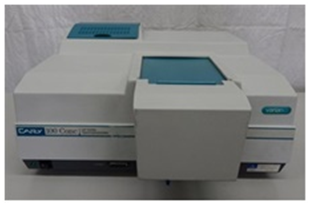
Brief Description
UV-Vis spectrophotometer is one of the most frequently used structural characterization techniques. Molecules containing π-electrons or non-bonding electrons (n-electrons) can absorb the energy in the form of ultraviolet or visible light to excite these electrons to higher anti-bonding molecular orbitals. The more easily excited the electrons (i.e. lower energy gap between the HOMO and the LUMO), the longer the wavelength of light it can absorb. There are four possible types of transitions (π-π*, n-π*, σ-σ*, and n-σ*), and they can be ordered as follows: σ-σ* > n-σ* > π-π* > n-π*.
Applications
Qualitative analysis and quantitative determination of UV/Vis active analytes, namely, organic compounds, biological macromolecules, etc.
User Instructions
Sample must be pure and all contaminants must be removed. Sample weight should be minimum 5 mg for solid samples and 5 ml for liquid samples Solvent used for dissolution should be specified and the user should provide the same for blank determination if the solvent is rare and costly.
2. Fourier Transform Infra Red Spectrometer (FTIR)
Instrument Details
Manufacturer: ThermoFisher Scientific, USA Model: Nicolet 5700 Specifications: Spectral range: 4000 cm-1 - 350 cm-1. Resolution: 0.4 cm-1 Diamond ATR
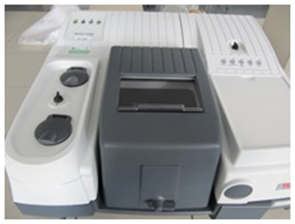
Brief Description
Infrared spectroscopy (IR spectroscopy or vibrational spectroscopy) involves the interaction of infrared radiation with matter. It covers a range of techniques, mostly based on absorption spectroscopy. As with all spectroscopic techniques, it can be used to identify and study chemicals. Samples may be solid, liquid, or gas. The method or technique of infrared spectroscopy is conducted with an instrument called an infrared spectrometer to produce an infrared spectrum. An IR spectrum can be visualized in a graph of infrared light absorbance (or transmittance) on the vertical axis vs. frequency or wavelength on the horizontal axis. Typical units of frequency used in IR spectra are reciprocal centimeters (sometimes called wave numbers), with the symbol cm−1.
Applications
Determination of the functional groups present in compounds, Determination of molecular structure and to follow the course of chemical reactions.
User Instructions
Sample must be pure and all contaminants must be removed. Sample weight should be around 2mg for solid samples, 2ml for liquid For film samples, square specimen of approximately 1x1 cm2 is required
3. Analytical Gel Permeation Chromatograph / High Performance Liquid Chromatograph
Instrument Details
Manufacturer: Waters, USA Model: Waters 600 Specifications: Detectors: UV (Waters 2487), RI (Waters 2414), ELS (Waters 2424). Column: C18
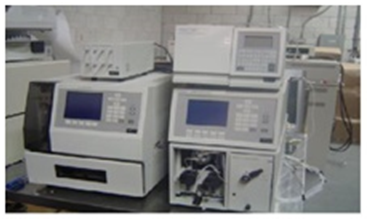
Brief Description
High-performance liquid chromatography (HPLC; formerly referred to as high-pressure liquid chromatography), is a technique in analytical chemistry used to separate, identify, and quantify each component in a mixture. It relies on pumps to pass a pressurized liquid solvent containing the sample mixture through a column filled with a solid adsorbent material. Each component in the sample interacts slightly differently with the adsorbent material, causing different flow rates for the different components and leading to the separation of the components as they flow out the column.
Applications
Purity assay Analytical separation and Estimation of components of mixtures Molecular weight determination using Gel Permeation Chromatography
User Instructions
Sample volume should be around 2 ml (adequately concentrated solution) Provide standards together with HPLC samples for identification and quantification Specify the method (mobile phase, detector, flow rate, temperature, etc)
4. Differential Scanning Calorimeter (DSC)
Instrument Details
Manufacturer: TA Instruments, USA Model: Q100 Specifications: Equipped with a refrigerated cooling system, Scan temperature range: -90 to 600oC (nitrogen atmosphere). Modulated DSC option for understanding complex thermal curves and to increase the sensitivity of weak transitions
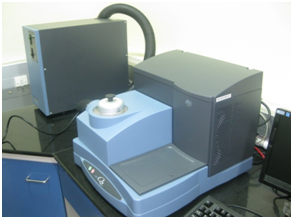
Brief Description
Differential scanning calorimetry, or DSC, is a thermoanalytical technique in which the difference in the amount of heat required to increase the temperature of a sample and reference is measured as a function of temperature. Both the sample and reference are maintained at nearly the same temperature throughout the experiment. Generally, the temperature program for a DSC analysis is designed such that the sample holder temperature increases linearly as a function of time. The reference sample should have a well-defined heat capacity over the range of temperatures to be scanned.
Applications
Determination of heat flow associated with phase transitions or reactions such as melting, crystallization, glass transition, curing, sorption, etc. Determination of crystallinity, degree of curing, heat capacity, crystalline impurities, etc. Oxidative stability, Polymorphism. Determination of weak thermotropic changes using MDSC analyzing reversible and irreversible thermal changes.
User Instructions
10-30 mg Sample is required for analysis Required temperature range and the heating rate should be specified Give details about the decomposition products associated with heating cycle of your sample. Samples likely to react with the sample holder materials (Al, Pt) will not be accepted for Thermal Analysis Explosive, poisonous samples and samples giving rise to toxic gases on heating cannot be accepted for Thermal Analysis
5. Differential Scanning Calorimeter (DSC)
Instrument Details
Manufacturer: TA Instruments, USA Model: Q20 Specifications: Equipped with a refrigerated cooling system, Scan temperature range: -900C to 5500C (nitrogen atmosphere)

Brief Description
Differential Scanning Calorimetry is one of the most frequently used thermal characterization techniques. In this technique the difference in energy input into a sample and a reference material is measured as a function of temperature, while the sample and reference material are subjected to a controlled temperature program.
Applications
Determination of heat flow associated with phase transitions or reactions such as melting, crystallization, glass transition, curing, sorption, etc. Determination of crystallinity, degree of curing, heat capacity, crystalline impurities, etc. Oxidative stability, Polymorphism
User Instructions
10-30 mg Sample is required for analysis Required temperature range and the heating rate should be specified Give details about the decomposition products associated with heating cycle of your sample. Samples likely to react with the sample holder materials (Al, Pt) will not be accepted for Thermal Analysis Explosive, poisonous samples and samples giving rise to toxic gases on heating cannot be accepted for Thermal Analysis
6. Simultaneous Differential thermal analysis and Thermo gravimetric analysis (DTA-TGA)
Instrument Details
Manufacturer: TA Instruments, USA Model: SDT Q 600 Specifications: Temperature range: Room temperature to 15000C (nitrogen atmosphere)
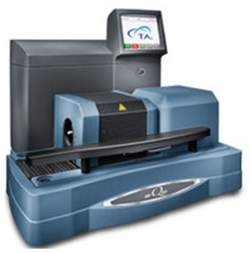
Brief Description
In differential thermal analysis, the temperature difference between a reactive sample and a non-reactive reference is determined as a function of time, providing useful information about the temperatures, thermodynamics and kinetics of reactions. Thermogravimetric analysis determines the weight gain or loss of a condensed phase due to gas release or absorption as a function of temperature. In combined DTA-TGA (simultaneous thermal analysis: STA) system both thermal and mass change effects are measured concurrently on the same sample (DTA, TG, DTG). The main concern in the design of these instruments is extracting the thermocouple signals without interfering with the free float of the balance.
Applications
Measures both weight changes & enthalpy changes associated with transitions and reactions in a material as a function of temperature (or time) under a controlled atmosphere Thermal stability of the materials and their compositional analysis. Differentiates endothermic and exothermic events, which are not associated weight change (e.g. melting and crystallization) from those which involve weight changes (e.g. degradation).
User Instructions
Provide test material code, nature and chemistry 10-30 mg Sample is required for analysis Required temperature range and the heating rate should be specified Give details about the decomposition products associated with heating cycle of your sample. Samples likely to react with the sample holder materials (Al, Alumina, Pt) will not be accepted for Thermal Analysis Explosive, poisonous samples and samples giving rise to toxic gases on heating cannot be accepted for Thermal Analysis
7. Texture Analyser
Instrument Details
Manufacturer: Stable Micro Systems, UK Model: TA.XT Plus Specifications: Force range: +/-50 Kg, Force resolution: 0.1 gm, Speed range: 0.01-20 mm/sec
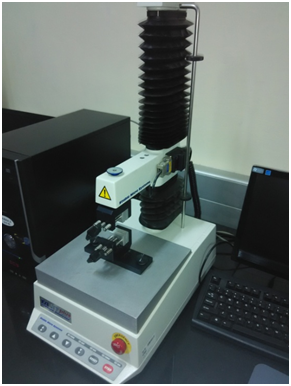
Brief Description
Texture analysis is the mechanical testing of food, cosmetics, pharmaceuticals, adhesives and other consumer products either in compression or in tension. Texture Analysers assess textural properties by capturing force, distance and time data at a rate of up to 500 points per second. Samples are either placed on the base of the texture analyser or held between two suitable fixtures. In a simple test, the arm of the texture analyser containing a loadcell moves down to penetrate or compress the product, and then returns to its initial position.
Applications
Mechanical testing of films/tissues (Compression and tension) Tests fracturability, mucoadhesiveness, gel strength, peel strength, burst strength, etc. Consistency measurements of emulsions, creams and gels, adhesiveness of patches, etc.
User Instructions
Exact nature of the sample, required parameters should be mentioned Explosive and poisonous samples cannot be analyzed
8. Confocal Raman Microscope with Atomic Force Microscope Accessory
Instrument Details
Manufacturer: WITec GmbH, Germany Model: Alpha300 RA Specifications: Excitation Laser 1. Frequency doubled Nd:YAG dye laser [max power output 40 mW at 532 nm], Excitation Laser 2. High Power Single Frequency Diode Laser [300 mW output power at 785 nm], Contact mode and AC mode (tapping) in AFM mode, Signal detected: Topography, Vertical resolution: <0.3nm, Lateral resolution: 5nm (50A), Scan range limits: 200 micrometer x 200 micrometer with Mapping.
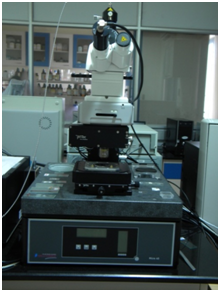
Brief Description
The Raman effect is based on light interacting with the chemical bonds of a sample. Due to vibrations in the chemical bonds the interaction with photons causes specific energy shifts in the back scattered light that appear in a Raman spectrum. The Raman spectrum is unique for each chemical composition and can provide qualitative and quantitative information of the material. Confocal Raman microscopy is a high-resolution imaging technique that is widely used for the characterization of materials and specimens in terms of their chemical composition. No labeling or other sample preparation techniques are necessary. By combining confocal Raman imaging with AFM, the chemical properties of the sample can be easily linked with the surface structure.
Applications
Determination of chemical structure of molecules by Micro Raman Spectroscopy Confocal Raman Spectroscopy imaging (hyperspectral image generation with information of complete Raman Spectrum at pixel level). Chemical mapping of distribution of components in a mixture by Raman imaging and depth profiling, e.g., drug in excipients/tablets, drug eluting stent coatings, live cell imaging etc. Atomic Force Microscopy – Acquisition of AFM contact and AFM AC (non-contact) mode images. Surface topography on the nanometer scale. Lateral resolution up to 1nm. Depth resolution < 0.3 nm.
User Instructions
Sample Size should be Min. 120 mm in X- and Y-direction, 25 mm in height Nature of the sample has to be mentioned 50-100 mg sample (solid/liquid) is required
9. Fluorescent Microscope
Instrument Details
Manufacturer: Leica, Germany Model: DMI3000B Specifications: Inverted microscope; Light source: EL6000; Digital camera: DFC 420C; Filter cubes: A, I3, N2.1 & GFP + bright field; Software: Leica Application Suite V3.8 Objectives: 5x N Plan NA = 0.12 WD = 14mm; 10 x HI Plan NA = 0.22 WD = 7.8mm; 20 x N Plan NA = 0.35 WD = 6.9mm; 40 x N Plan NA = 0.55 WD = 3.3-1.9; 63 x PL Fluotar NA = 0.7 WD = 2.6mm
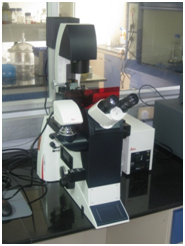
Brief Description
A fluorescence microscope is an optical microscope that uses fluorescence instead of, or in addition to, reflection and absorption to study properties of organic, inorganic and biological samples. The specimen is illuminated with light of a specific wavelength which is absorbed by the fluorophores, causing them to emit light of longer wavelengths. The illumination light is separated from the much weaker emitted fluorescence through the use of spectral emission filters.
Applications
Quick and easy screening of fluorescent samples Live cell imaging
User Instructions
Samples having photobleaching nature cannot be analysed. Samples should have sufficient fluorescent intensity
10. Multifunctional Microplate Reader
Instrument Details
Manufacturer: TECAN, Austria Model: Infinite M200 Specifications: Monochromator based equipment that supports 6-384 well microplate formats, Fluorescence Intensity measurement: Top & Bottom, Fluorescence Time Resolved measurements, Absorbance range: 230nm-1000nm, Fluorescence scan – Excitation: 230-850nm; Emission: 280-850nm
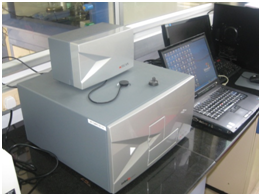
Brief Description
Microplate Reader is used to detect biological, chemical or physical events of samples in microtiter plates. They are widely used in research, drug discovery, bioassay validation, quality control and manufacturing processes in the pharmaceutical and biotechnological industry. Common detection modes for microplate assays are absorbance and fluorescence intensity.
Applications
Fluorescence Intensity and Absorbance measurements with microplates Fluorescence and Absorbance scan with microplates
User Instructions
Nature of the sample and solvent should be mentioned Spectral parameters details should be provided
11. Electrochemical Quartz Crystal Nanobalance
Instrument Details
Manufacturer: ELCHEMA, USA Model: EQCN-700 Specifications: Mass change ranges: +/- 100µg to +/- 100ng, Resolution: 0.01ng
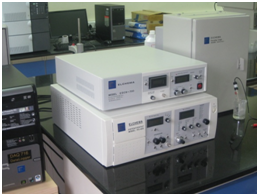
Brief Description
Electrochemical Quartz Crystal Nanobalance can serve as an extremely sensitive device for measurements of very small mass changes, from sub-nanogram quantities to 100 micrograms. The gold working electrode is in the form of a thin film, and is placed on one side of a quartz single crystal wafer which oscillates in the shear mode at nominal 10 MHz frequency. Any change in the mass rigidly attached to the working electrode results in the change of the quartz crystal oscillation frequency. The frequency shift is measured by the instrument and converted to mass units.
Applications
Piezoelectric nanogravimetry for the measurement of mass changes on an electrode surface in the range of ng/cm2 Detection of atomic monolayers forming on the surfaces Study of interfacial processes occurring at or near the electrode surface such as surface adsorption or desorption Study of protein interfacial behaviours and adsorption behaviour of biologically active molecules
User Instructions
Exact nature of the sample should be mentioned
12. Luminescent Image Analyser
Instrument Details
Manufacturer: Fuji Film, Japan Model: LAS 4000 Specifications: Filters available – 460nm blue, 520nm green, 630nm red, 710nm IR, 312 & 365 nm UV and white light
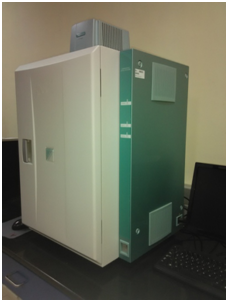
Brief Description
By using wide variety of light sources and optical filters fluorescence and luminescence of the samples especially biological samples can be quantified.
Applications
Multipurpose CCD camera system for sensitive and quantitative imaging of membranes, gels, small animals, colony counting, etc.
User Instructions
Nature of the sample should be mentioned Details of the spectral parameters are required
13. Rapid Visco Analyser
Instrument Details
Manufacturer: Newport Scientific, Australia Model: RVA Starch Master 2 Specifications: Viscosity range: 40-14000cP at 80rpm, 20-8000 at 160rpm, Viscosity accuracy: ±3%, Speed range: 20-1000rpm, Temperature range: ambient to 990C
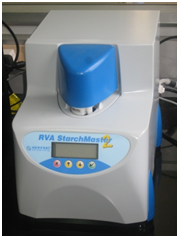
Brief Description
The RVA is a viscometer with ramped temperature and variable shear capability optimized for testing the viscous properties of different types of samples. However, it is important to highlight its versatility due to its capability of analyzing the viscosity in heating-cooling cycles.
Applications
For the determination of solution viscosity of biopolymers Stirring viscometer with ramped temperature and changeable shear capability for the testing of viscous properties of starch, alginate, chitosan, hydrocolloids, proteins, etc.
User Instructions
Thermal stability of the sample should be mentioned Required temperature should be mentioned
14. Environmental chamber
Instrument Details
Manufacturer: CM Enviro Systems, India Model: 225 L Specifications: Temperature range: 2-900C, Humidity range: 20-90% RH, Light: On/Off
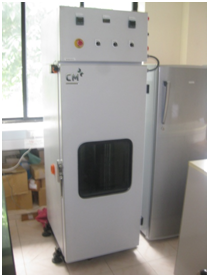
Brief Description
An environmental chamber is an enclosure used to test the effects of specified environmental conditions on biological items, industrial products, materials, and electronic devices and components.
Applications
Aging/stability studies in specified environmental conditions Accelerated ageing/stability studies Shelf life estimation
User Instructions
Nature of the sample should be mentioned Explosive and poisonous samples cannot be submitted Exact stimulating conditions should be mentioned
15. High Performance Liquid Chromatograph
Instrument Details
Manufacturer: Shimadzu, Japan Model: LC-2010A HT Specifications: Detector: UV, Autosampler: up to 210 samples at one go, Column: C18
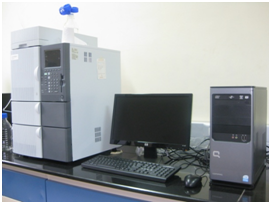
Brief Description
High-performance liquid chromatography (HPLC) can be used to separate, identify, and quantify each component in a mixture. It relies on pumps to pass a pressurized liquid solvent containing the sample mixture through a column filled with a solid adsorbent material. Each component in the sample interacts slightly differently with the adsorbent material, causing different flow rates for the different components and leading to the separation of the components as they flow out the column.
Applications
Analytical separation of individual chemical compounds from complex mixtures Identification and quantification of compounds
User Instructions
Solvent for mobile phase should be mentioned or solubility of compound in volatile solvent MS-DS (Material Safety Data Sheet) should be given along with samples to ensure that there sample being given. Samples should not be toxic or hazardous. Samples will not be accepted unless MS-DS Fluorine solvent and Halo acids cannot be used for analysis
